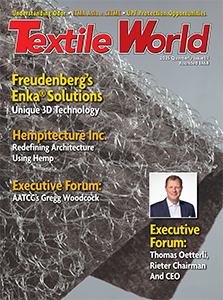DENKENDORF, Germany — September 21, 2017 — At the end of November, Stuttgart and partner country the United States will together host what is probably the most important congress for technical textiles in Europe. The stated aim of the Aachen-Dresden-Denkendorf International Conference. 30 November until 1 December is above all to inspire medium-sized enterprises and developers to take a look at new research results and -tech applications. The key focus points of the congress are high-performance fibers, medical textiles and fiber composites.
Users in the construction industry will undoubtedly be particularly by research and development solutions such as 3dTEX spacer fabrics for textile-based building envelopes, solar films for shading textiles or prefabricated steel-free reinforced concrete parts. Medium-sized medical engineering companies might benefit significantly from textile UV sensors, new results in wireless health monitoring or filaments for chitosan resorbable OP suture material, among much else. Highlights such as these will be showcased in Stuttgart alongside exceptionally economical load bearing carbon fiber frames or even fiber composite recycling products.
New wound dressings, silicone-based sensor systems for monitoring body function
At the ADD, Dr. Daniela Beck of Kelheim Fibres GmbH will present bandage material made from collagen-containing viscose fibers which has been developed jointly with Resorba Medical and partners from the Sächsisches Textilforschungsinstitut in Chemnitz and the Hohenstein Institutes. These bio-based multifunctional fibers are also usable for many other medical applications, and can be used in gel-forming or pH-regulating applications or as a pH indicator for example.
In Denkendorf, not far from Stuttgart, the technical staff at DITF — Europe‘s largest textile research facility — have developed a device for characterizing the liquid uptake of hygiene wovens. It is expected to become invaluable wherever the liquid absorption, storage and delivery capabilities of textile structures are important for evaluationg new utility functions. This would apply most especially to medical products, bed linen and towels, but also for sport or work clothing. The many other ideas for product innovations which may benefit medium-sized enterprises especially include for example wireless medical monitoring systems in the form of smart textiles, efficient production methods for medical UV sensors, new interpretation capabilities for textiles and other surfaces that come into contact with blood and tissue, or a textile-based bio-battery for medical purposes.
In Search Of Textile-Based Innovations
“Smart textiles or textile composites are extremely diversified material classes which medium-sized enterprises can integrate in their smart or ultra-lightweight product innovations tomorrow“ says Prof. Dr.-Ing. Götz Gresser, member of the board of German Institutes of Textile and Fibre Research Denkendorf (DITF) and host of the textile congress. As a nexus for dialogue between research and industry the ADD serves as a venue for presentations on new trends, technologies and application-ready solution concepts and stands at the threshold of their practical implementation.
Posted September 21, 2017
Source: DITF Denkendorf




